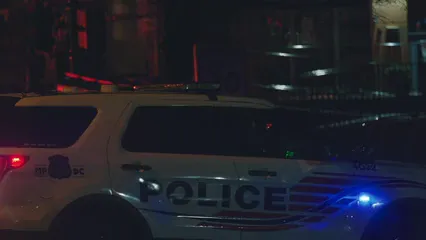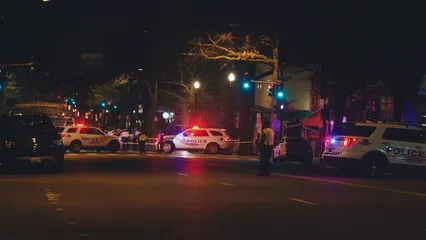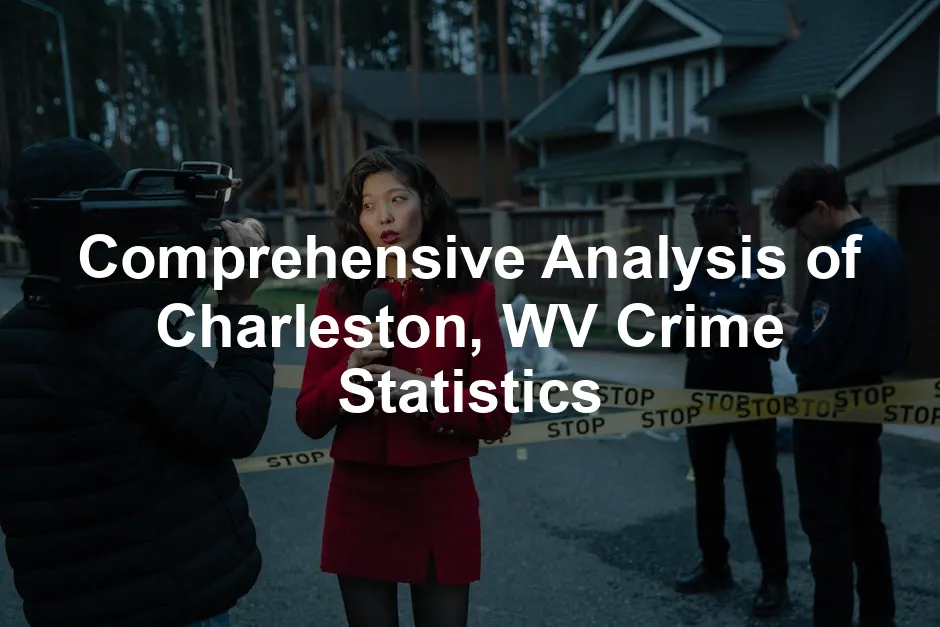Introduction
Crime statistics are essential for understanding community safety. In Charleston, West Virginia, these numbers play a crucial role for residents, newcomers, and policymakers alike. By examining crime trends, individuals can make informed decisions about safety and living conditions. A thorough analysis of crime data helps to identify patterns, potential risks, and areas needing improvement.
Data for this analysis come from various credible sources. Reports from local law enforcement agencies, the FBI, and crime analysis websites provide a comprehensive view of Charleston’s crime landscape. These sources ensure that the information is accurate and up-to-date, reflecting the realities of the community.
The objective of this article is straightforward: to provide a detailed overview of crime statistics in Charleston, focusing on trends and comparisons. By presenting this information, we aim to help readers grasp the safety dynamics in the area. Understanding these statistics can empower residents and prospective movers to engage with their community more actively and effectively.
With insights into violent and property crime rates, alongside comparisons to national averages, this article aims to paint a clear picture of crime in Charleston. Whether you’re a long-time resident or considering a move, knowledge is power when it comes to community safety. For more information on the statistical analysis of safety, check out an introduction to statistical learning with python book length.
Understanding crime statistics is crucial for community engagement and safety awareness. an introduction to statistical learning with python book length
Overview of Crime in Charleston, WV
General Crime Statistics
Charleston, WV, has significant crime statistics that can’t be ignored. The overall crime rate stands at 49.91 per 1,000 residents, marking it as one of the higher crime areas in the country. With a total population of around 47,129, this translates to a notable number of incidents. The significant figure of 50 crimes per 1,000 residents places Charleston among the highest in the U.S. To enhance your security, consider investing in a Sabre Home Security System. It’s like having a superhero in your home – minus the cape!
When we break down these numbers further, the violent crime rate is particularly alarming at 6.58 per 1,000 residents. In contrast, property crimes dominate with a staggering rate of 43.33 per 1,000 residents. This means that the risk of becoming a victim of crime is higher in Charleston than in many other places. In fact, more than 99% of communities in West Virginia report lower crime rates than Charleston.
Understanding these statistics is essential. They provide context for residents and newcomers alike. Comparing Charleston’s crime rates to national averages reveals a stark reality. The national average for violent crime is approximately 4 per 1,000 residents, meaning Charleston experiences nearly double that rate. Similarly, property crime rates are alarmingly high compared to the national median, which has implications for the quality of life in the area.
These figures underscore the importance of community awareness and proactive measures to enhance safety. Awareness of local crime dynamics can help shape community responses and support initiatives aimed at reducing crime rates. Ultimately, understanding Charleston’s crime statistics is vital for residents to navigate their environment safely and effectively. You might also want to check out the SimpliSafe 12 Piece Wireless Home Security System for a more comprehensive approach to keeping your home safe!

Crime Rates Breakdown
Charleston, WV, presents a unique crime landscape. With a violent crime rate of 6.58 per 1,000 residents, it certainly raises eyebrows. This figure doesn’t just stand alone; it positions Charleston significantly above the national average of roughly 4 per 1,000 residents. If you thought your neighborhood was tough, consider this: the chance of becoming a victim of violent crime in Charleston is about 1 in 152. That’s like flipping a coin and hoping for tails, but you get heads instead!
Now, let’s talk about property crime. Here, Charleston’s rate is even more pronounced at 43.33 per 1,000 residents. This staggering number places it squarely among the cities with the highest property crime rates in the U.S. To put it in perspective, your odds of being a victim of property crime are a shocking 1 in 23. That’s like attending a party of 23 people and realizing one of you is destined to lose something valuable. Yikes! You might want to consider a Kidde Fire Extinguisher for safety’s sake!
When compared to other cities in West Virginia, Charleston doesn’t fare well. Over 99% of communities in the state report lower crime rates. So, while you might think you’re in a bustling metropolis, you’re actually navigating through a crime-infested maze that many others have managed to avoid. It’s essential for residents and potential movers to recognize these statistics. They offer a clearer picture of what daily life might look like in Charleston.
The data paints a vivid picture of safety concerns. Although Charleston boasts beautiful parks and a rich history, its crime rates create a cloud over its charm. Understanding these statistics can empower residents to take proactive measures for safety, fostering a community that is well-informed and engaged. After all, safety isn’t just about numbers; it’s about the quality of life for everyone in the city. If you’re looking to enhance your home security, consider a Ring Video Doorbell Pro 2. It’s like having a bouncer for your front door!

Community Impact
Violent crime in Charleston has a ripple effect. It doesn’t just stay within the confines of crime reports; it seeps into the daily lives of residents. Fear becomes a neighbor, lurking in the shadows during evening walks or when locking doors at night. This anxiety isn’t just an emotional response; it significantly impacts the quality of life.
Imagine living in a neighborhood where the sounds of police sirens are more familiar than the laughter of children playing outside. That’s the reality for many Charleston residents. A heightened sense of vulnerability can lead to isolation. People might hesitate to venture out for evening activities. Local businesses may also suffer, as potential customers choose to stay home instead of risking a night out.
Community bonds weaken when trust erodes. Individuals may become suspicious of their neighbors, leading to a less cohesive environment. A shared sense of safety often breeds camaraderie, while fear can breed division. Residents may feel compelled to invest in security systems, further escalating feelings of distrust. If you’re considering such an investment, a Master Lock Bluetooth Smart Padlock is a great choice for keeping your belongings secure!
Moreover, the implications extend beyond personal safety. Property values can plummet in areas with high crime rates, which in turn affects local economies. Schools may see declining enrollments as families move away, seeking safer havens. This cycle can create a community that struggles to thrive, caught in a web of fear and uncertainty.
Detailed Breakdown of Property Crimes
Types of Property Crimes
Charleston’s property crime statistics paint a concerning picture. In 2022, there were 432 burglaries, 1,456 larcenies, and 154 motor vehicle thefts reported. Burglary, defined as the unlawful entry into a building with intent to commit theft, accounted for a significant portion of property crimes. With a rate of 9.17 per 1,000 residents, it’s clear that many people feel their homes are at risk.
Larceny is even more prevalent, with a staggering 30.89 incidents per 1,000 residents. This includes thefts exceeding $50, encompassing everything from a stolen bike to shoplifting. The sheer volume of these crimes suggests that residents often experience the unsettling feeling of being watched or targeted. A community that should be vibrant can feel like a minefield, where the next theft could happen at any moment. To combat this, having a Blink Outdoor Security Camera can give you peace of mind!
Motor vehicle theft, while less frequent, still poses a significant concern. With 154 reported cases, it reflects a broader issue of safety. For many, their vehicle is not just a mode of transportation; it’s a lifeline to work, school, and social activities. The loss of a vehicle can severely disrupt daily life, leaving individuals scrambling for alternative arrangements.
The prevalence of these property crimes creates a cycle of anxiety. Residents may feel the urge to take extra precautions, investing in security measures that can strain finances. This not only affects individuals but also the community’s overall sense of safety and trust. Consider using a Honeywell Home RTH9585WF Smart Thermostat to ensure your home is both safe and comfortable!

Year-over-Year Trends
Examining the trends in property crime rates reveals a troubling trajectory. Over recent years, there has been a noticeable increase in property crimes. Comparing these rates to violent crime rates provides a clearer context. While violent crime tends to garner more media attention, it’s often property crime that affects the daily lives of residents more profoundly.
For instance, while violent crimes decreased slightly in Charleston, property crimes surged. The juxtaposition of a declining violent crime rate alongside a climbing property crime rate highlights the shifting nature of safety concerns. Residents may feel a false sense of security, believing that violent crime is on the decline while still grappling with the day-to-day reality of theft and burglary.
This trend emphasizes the importance of community vigilance. Residents must stay informed and proactive in engaging with local law enforcement and community programs aimed at crime prevention. Understanding these statistics is crucial for fostering a safer environment, where neighbors look out for one another and local initiatives can thrive. If you’re looking for a reliable way to filter your water during emergencies, consider a LifeStraw Personal Water Filter.
In conclusion, the landscape of property crime in Charleston is complex and evolving. The statistics tell a compelling story of challenges, but with community involvement and awareness, residents can work toward creating a safer, more vibrant Charleston for all.
Community Response
Charleston, WV, has faced its share of challenges regarding property crime. However, the community is not sitting idle. Local initiatives and law enforcement agencies are stepping up to tackle these issues head-on. One notable effort is the Charleston Police Department’s increased focus on community policing. This approach fosters relationships between officers and residents. When neighbors know their police officers, it creates a sense of trust and cooperation that’s hard to beat.
In addition to law enforcement efforts, various community programs aim to enhance neighborhood safety. For instance, community watch programs have gained traction. Residents band together to keep an eye on one another’s properties. This grassroots movement not only helps deter crime but also builds a stronger sense of community. After all, nothing says “we care” like a group of neighbors watching out for each other!
Moreover, local organizations offer safety workshops and seminars. These educational initiatives teach residents about crime prevention strategies. Knowledge is power, and empowering citizens can make a significant impact. By learning how to secure their homes better and recognize suspicious activities, residents can contribute to a safer Charleston. If you’re looking to upgrade your kitchen while enhancing safety, check out the Amazon Basics 12-Piece Kitchen Knife Set.

Comparative Analysis
State and National Comparisons
When we compare Charleston’s crime rates to both West Virginia and national averages, the numbers tell a compelling story. Charleston’s overall crime rate sits at around 49.91 per 1,000 residents. In contrast, the state average is significantly lower at 12.3 property crimes per 1,000 residents. The national median for property crime stands at 20.00. That’s a striking difference!
In the violent crime category, Charleston’s rate is 6.58 per 1,000 residents, while West Virginia averages 2.78. Nationally, the median is approximately 4.00. This disparity shows that Charleston is grappling with crime levels that exceed both state and national norms.
To illustrate these comparisons further, here’s a concise table:
| Crime Type | Charleston | West Virginia | National Average |
|---|---|---|---|
| Overall Crime Rate | 49.91 | 12.3 | 20.00 |
| Violent Crime Rate | 6.58 | 2.78 | 4.00 |
| Property Crime Rate | 43.33 | 12.3 | 20.00 |
This data clearly outlines that potential residents should approach their move to Charleston with caution and awareness. For a comprehensive analysis of safety in another area, you can refer to fremont crime statistics.

Understanding crime statistics in different areas can provide valuable insights into community safety. fremont crime statistics
Nearby Communities Comparison
Looking beyond Charleston, let’s examine the crime rates in neighboring areas like South Charleston and Dunbar. South Charleston has a total crime rate of 55 per 1,000 residents. This rate is alarmingly high, making it one of the more dangerous areas in the state. The violent crime rate is 6.45 per 1,000, while property crimes stand at a staggering 48.12 per 1,000 residents.
Dunbar, on the other hand, offers a slightly more reassuring picture. With a crime rate of 44 per 1,000 residents, it still shows significant crime but is less than South Charleston and Charleston itself. The violent crime rate there is 6.05, while property crimes sit at 37.47 per 1,000 residents.
Here’s a quick summary of the nearby communities:
| Community | Total Crime Rate | Violent Crime Rate | Property Crime Rate |
|---|---|---|---|
| Charleston | 49.91 | 6.58 | 43.33 |
| South Charleston | 55.00 | 6.45 | 48.12 |
| Dunbar | 44.00 | 6.05 | 37.47 |
These comparisons highlight the need for potential residents to consider safety when looking at Charleston. The implications of higher crime rates can affect everything from housing prices to insurance costs. It’s crucial for newcomers to engage with local initiatives and stay informed about safety measures to enhance their living experience in Charleston and its surrounding areas. You might also find it beneficial to have a TP-Link Kasa Smart Wi-Fi Plug to manage your home devices securely!

Local Perception of Crime
Survey Findings
In a recent survey conducted by AreaVibes, residents of Charleston shared their thoughts on crime and safety. Out of the 88 respondents, an overwhelming 84% reported feeling unsafe walking alone at night. This statistic can be troubling. Only 16% of residents felt there was virtually no crime in their area and expressed confidence in their safety. It appears that the community’s perception of crime doesn’t align with the charm of Charleston’s picturesque streets. Instead, many residents experience a sense of unease, as if shadows lurk around every corner.
The survey results indicate a clear divide in how safety is perceived in Charleston. While some boast about the city’s historical beauty and friendly atmosphere, others can’t shake the feeling of vulnerability. This disparity highlights the importance of addressing public concerns regarding safety. After all, a city can have all the charm in the world, but if residents don’t feel secure, the allure can quickly fade. To help ease your worries, consider reading The Subtle Art of Not Giving a F*ck by Mark Manson for some perspective!

Safety Ratings
When it comes to safety ratings, Charleston receives mixed feedback. A safety grade of C- reflects a community grappling with both violent and property crimes. Many residents believe that law enforcement visibility is adequate but question the effectiveness of their responses. According to a separate poll, 52% of participants indicated that police are visible but slow to respond in emergencies. This sentiment suggests that while officers are present, the community may not feel adequately protected.
Furthermore, the perception of law enforcement’s effectiveness can significantly influence how safe residents feel. If citizens view police as unresponsive, it can erode trust and further exacerbate feelings of insecurity. This relationship between community trust and crime perception is critical. It emphasizes the need for law enforcement to not only be visible but also proactive in building rapport with residents.
Charleston’s safety ratings reveal an ongoing challenge. The disparities in perception underline the importance of continuous efforts to enhance community safety. Engaging with residents, improving police responsiveness, and addressing concerns can foster a sense of security. Ultimately, the community’s well-being hinges on the collaborative relationship between law enforcement and the citizens they serve. If you’re looking for inspiration, consider reading The 7 Habits of Highly Effective People by Stephen R. Covey.
Law Enforcement and Community Safety Efforts
Police Presence
Charleston boasts a police presence of 3.6 officers per 1,000 residents, which is higher than both state and national averages. This statistic suggests that the city is committed to enhancing public safety. However, one must wonder: is more police presence the ultimate solution? While the numbers seem reassuring, the effectiveness of law enforcement ultimately hinges on community engagement and perception.
Community policing initiatives are pivotal in this equation. By focusing on building relationships with residents, officers can foster trust and cooperation. Programs that encourage officers to engage with neighborhoods can lead to crime reduction. When residents feel comfortable reporting suspicious activities, it creates a safer environment for everyone. To support your home’s safety, consider adding a Zmodo 1080p Outdoor Security Camera to your arsenal!

Community Programs
Beyond law enforcement, Charleston offers several community programs aimed at crime prevention and engagement. Initiatives targeting at-risk populations help address underlying issues contributing to crime. For instance, partnerships between law enforcement and local organizations provide support for those in need. These collaborations not only promote safety but also help build a stronger sense of community.
Neighborhood watch programs have gained traction, encouraging residents to unite in keeping an eye on their surroundings. These grassroots efforts can deter crime effectively. Additionally, community workshops focused on awareness and crime prevention strategies empower citizens. Knowledge is power, and well-informed residents are more likely to contribute to a safer Charleston. For those who enjoy outdoor activities, consider a Coleman Portable Camping Quad Chair for your next neighborhood gathering!
In conclusion, while Charleston faces challenges regarding crime, the combined efforts of law enforcement and community programs create a foundation for improvement. Engaging residents, fostering trust, and addressing root causes will pave the way for a safer future. By working together, the city can enhance both safety and the quality of life for its residents.

Conclusion
Charleston, WV, presents a complex picture when it comes to crime statistics. The high rates of both violent and property crimes create a challenging environment for residents. Surveys reveal that many residents feel unsafe, reflecting a community grappling with fear. However, the city is not without hope. Law enforcement is actively working to improve safety, and community programs are making strides in engaging residents.
Understanding crime statistics in Charleston is essential. Knowledge empowers residents to take proactive measures, fostering a safer environment. Continuous efforts to enhance law enforcement responsiveness and community engagement can bridge the gap between perception and reality. If you’re interested in expanding your reading list, consider checking out Harry Potter Box Set (Books 1-7) for a magical escape!
Please let us know what you think about our content by leaving a comment down below!
Thank you for reading till here 🙂
FAQs
What are the safest neighborhoods in Charleston, WV?
Charleston has several neighborhoods where residents feel relatively safe. Areas like Loudon Heights and South Hills often receive positive feedback for their lower crime rates. Residents in these neighborhoods typically report feeling more secure, enjoying community events and outdoor activities without excessive worry.
How does Charleston’s crime rate compare to other cities in West Virginia?
Charleston’s crime rate is notably higher than other cities in West Virginia. For instance, South Charleston and Dunbar have lower rates of both violent and property crimes. This stark contrast emphasizes the unique challenges Charleston faces, making it essential for residents to be aware of their surroundings.
What resources are available for residents concerned about crime?
Residents concerned about crime can access a variety of resources. Local hotlines provide information on safety practices, while community organizations offer support to those affected by crime. Additionally, the Charleston Police Department encourages residents to report any suspicious activities, fostering a safer community.
How can residents contribute to crime reduction in their communities?
Active participation is key to crime reduction. Residents can join neighborhood watch programs, report suspicious activities, and engage in community safety workshops. By working together, they can create a more vigilant and supportive environment that deters crime.
Where can I find more up-to-date crime statistics for Charleston?
For ongoing updates on crime statistics, residents can visit reputable sources such as the FBI’s crime reports and neighborhood crime analytics websites. Local law enforcement also provides annual crime reports that detail trends and statistics, ensuring that residents stay informed.
All images from Pexels




